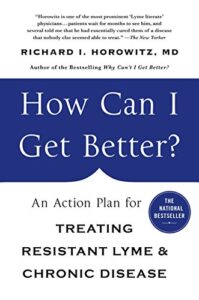Treatment
Additional Treatment Protocols

What You Need to Know
Based on available testing for Lyme disease, it can still be difficult to determine who has the illness, the most effective course of treatment, and when treatment can be discontinued. Because of this it is important to become knowledgeable about mainstream and alternative treatment methods in order to discuss options with your doctor.
For those with positive Lyme disease tests, the IDSA and CDC recommend a standard 10- to 14-day course of a single antibiotic therapy. However, even when treated early, the CDC concedes that an estimated 10% to 20% of Lyme patients continue to have symptoms for six months or more. The possibility of persistent symptoms even in the face of standard treatment is why these additional resources are important.
The below list of resources refer to treatment methods for both early and late stages of the disease.

International Lyme and Associated Diseases Society (ILADS) released their most recent treatment guidelines in 2014. They address three clinical questions – the usefulness of antibiotic prophylaxis for known tick bites, the effectiveness of erythema migrans treatment, and the role of antibiotic re-treatment in patients with persistent manifestations of Lyme disease.

Dr. Joseph Burrascano, a prior Board Member of ILADS, developed his own treatment guidelines in 2008. A leading authority in treating tick-borne diseases, Burrascano serves as an internist in East Hampton, N.Y. – an area hyper endemic for Lyme disease.
 Dr. Daniel Kinderlehrer, MD is a Internal Medicine Specialist in Denver, CO. He recently published a book titled Recovery from Lyme Disease: The Integrative Medicine Guide to Diagnosing and Treating Tick-Borne Illness which provides patients with a detailed road-map through their journey. This integrative approach offers the most up-to-date and comprehensive plan available for treating Lyme.
Dr. Daniel Kinderlehrer, MD is a Internal Medicine Specialist in Denver, CO. He recently published a book titled Recovery from Lyme Disease: The Integrative Medicine Guide to Diagnosing and Treating Tick-Borne Illness which provides patients with a detailed road-map through their journey. This integrative approach offers the most up-to-date and comprehensive plan available for treating Lyme.
 Dr. Richard Horowitz is a board certified internist in private practice in Hyde Park, N.Y. He is medical director of the Hudson Valley Healing Arts Center, an integrative medical center which combines both classical and complementary approaches in the treatment of Lyme Disease and other tick-borne disorders. In this book you will find emerging research on bacterial “persister” bacteria that can survive antibiotics and new therapies to get rid of them. It also contains as a seven-step action plan that patients and doctors can follow to ensure better health.
Dr. Richard Horowitz is a board certified internist in private practice in Hyde Park, N.Y. He is medical director of the Hudson Valley Healing Arts Center, an integrative medical center which combines both classical and complementary approaches in the treatment of Lyme Disease and other tick-borne disorders. In this book you will find emerging research on bacterial “persister” bacteria that can survive antibiotics and new therapies to get rid of them. It also contains as a seven-step action plan that patients and doctors can follow to ensure better health.
 Steven Buhner is an herbalist who is an expert on using alternative treatment methods to combat Lyme disease. His book, Healing Lyme: Natural Healing of Lyme Borreliosis and the Coinfections Chlamydia and Spotted Fever Rickettsiosis, examines the leading scientific research on lyme infection, its tests and treatments, and outlines the most potent herbal medicines and supplements that offer help – either alone or in combination with antibiotics – for preventing and healing the disease. It is the essential guide to lyme infection and its treatment. Thousands of people have used the protocol to successfully manage their symptoms.
Steven Buhner is an herbalist who is an expert on using alternative treatment methods to combat Lyme disease. His book, Healing Lyme: Natural Healing of Lyme Borreliosis and the Coinfections Chlamydia and Spotted Fever Rickettsiosis, examines the leading scientific research on lyme infection, its tests and treatments, and outlines the most potent herbal medicines and supplements that offer help – either alone or in combination with antibiotics – for preventing and healing the disease. It is the essential guide to lyme infection and its treatment. Thousands of people have used the protocol to successfully manage their symptoms.
 Dr. Brian A. Fallon, MD, MPH, is the director of the Center for Neuroinflammatory Disorders and Biobehavioral Medicine and director of the Lyme and Tick-Borne Diseases Research Center at Columbia University. He wrote a book titled Conquering Lyme Disease: Science Bridges the Great Divide. This book leverages research done by Columbia University to explain the immunologic, infectious, and neurologic basis of chronic symptoms, the cognitive and psychological impact of the disease, as well as current and emerging diagnostic tests, treatments, and prevention strategies.
Dr. Brian A. Fallon, MD, MPH, is the director of the Center for Neuroinflammatory Disorders and Biobehavioral Medicine and director of the Lyme and Tick-Borne Diseases Research Center at Columbia University. He wrote a book titled Conquering Lyme Disease: Science Bridges the Great Divide. This book leverages research done by Columbia University to explain the immunologic, infectious, and neurologic basis of chronic symptoms, the cognitive and psychological impact of the disease, as well as current and emerging diagnostic tests, treatments, and prevention strategies.
 Dr. Bill Rawls, a physician who battled chronic Lyme for years, published Unlocking Lyme in order to share emerging science, unique insights, and practical solutions he had developed using herbs and supplements. In this book you will learn the limitations of long-term antibiotic use, natural therapies for healing symptoms (including pain, depression, insomnia), as well as how to strengthen your immune system and embrace a healthier lifestyle so you can stay well.
Dr. Bill Rawls, a physician who battled chronic Lyme for years, published Unlocking Lyme in order to share emerging science, unique insights, and practical solutions he had developed using herbs and supplements. In this book you will learn the limitations of long-term antibiotic use, natural therapies for healing symptoms (including pain, depression, insomnia), as well as how to strengthen your immune system and embrace a healthier lifestyle so you can stay well.

